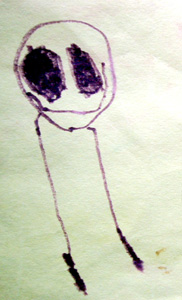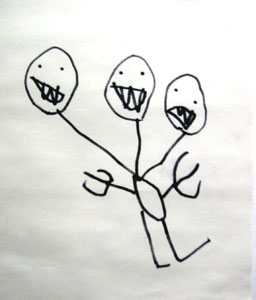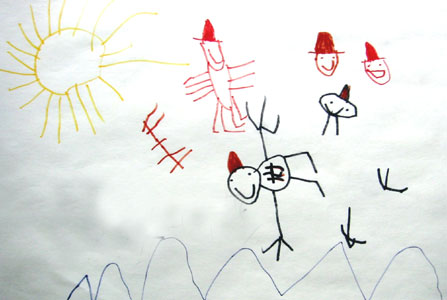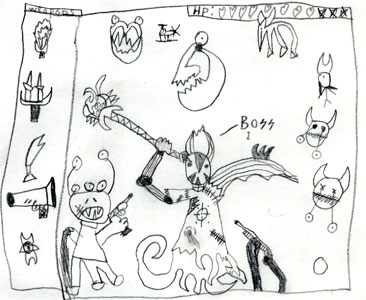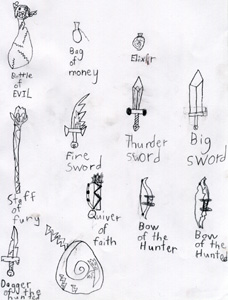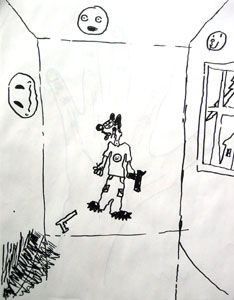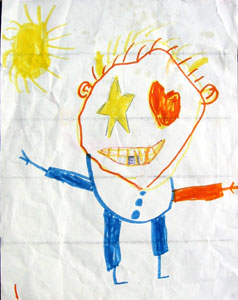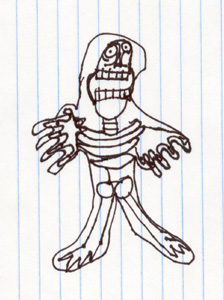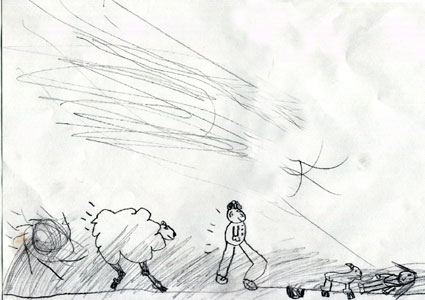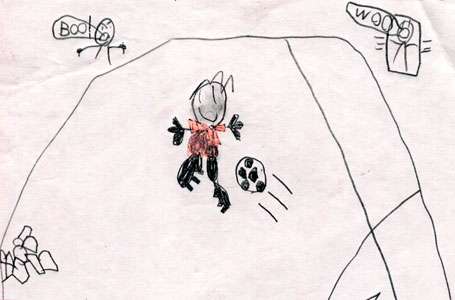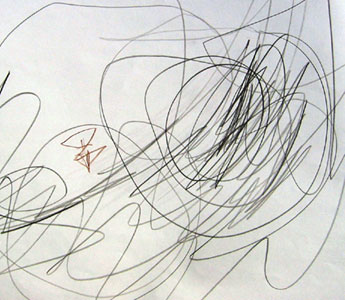
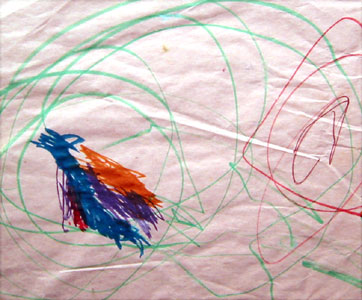
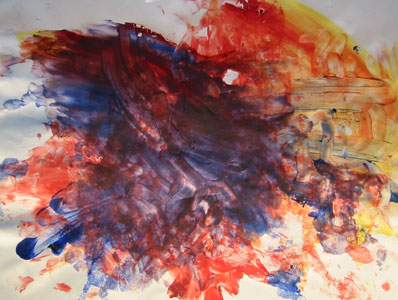
|
Scribbling Stage,
2 - 4 years
Disordered scribbling
Drawing characteristics:
Motor activity with large muscles, movement from shoulder, swing of arm makes line.
Grasps tool with whole hand, upside, sideways, fist or fingers.
Looks away while scribbling.
Space Representation:
Scribbles beyond edge of paper, ignores previous marks on page.
Human Figure representation:
None.
Controlled scribbling
Drawing characteristics:
Smaller marks, repeated motions that fill the page, uses wrist motion.
Experimentation, some dots and broken lines created by lifting tool off page .
Watches scribble while drawing.
Space Representation:
Stays within drawing area, draws around previous marks.
May concentrate on certain parts of drawing.
Human Figure representation:
Circles, lines, loops and swirls, which are prefigural.
Named scribbling
Drawing characteristics:
Greater variety of line, draws with intent and with a longer attention span.
Tool held between fingers.
Change made from kinesthetic thinking to imaginative thinking.
Space Representation:
Scribbles are placed purposely, lines become edges of shapes.
Previous marks on page utilized.
Empty space may take on meaning.
Human Figure representation:
Relates marks to things known, a scribble may be named as being a person,
actions also may be named, such as running, jumping, swinging.
Exercises:
1. Scribbling exercises should have a physical and therapeutic warm up value. Loosen up.
Consider both line and mass scribbling exercises. Use both arm and wrist motions.
2. Hold the tool clenched in fist, experiment with end pointed in both directions. Experiment with other ways to hold the tool. Keep the tool simple, a soft pencil or crayon is probably best. Work with energy, visualizing the development of ancient methods, such as spitting paint to create a primitive airbrush, smearing or gouging a line.
3. To draw, you must invent and develop ways to depict the world on a 2d surface. Imagine fiercely, as if it's all new. Draw concepts (cow, mom, Self, machines etc.). Naturalistic representation is not important.
4. Naming is also an aesthetic action. Change the concept of the drawing in mid process by changing identification of image. Choose a transformation, think a solution.
|
|
Preschematic Stage,
4 - 7 years
Drawing characteristics:
Shapes are geometric, and lose their value when removed from the whole.
Objects are not related to one another.
Placement and size of objects is determined subjectively.
Space Representation:
Space seems to surround the artist.
Objects seem to float around the page, and are distorted to fit the space available.
Sizes of objects are not in proportion to one another.
Paper is sometimes turned or rotated while drawing.
Human Figure representation:
The first representational attempt, a Head-Feet symbol, grows out of scribble.
It becomes a schema when it is repeated again and again,
It is flexible, constantly changing, looking out at viewer, usually smiling.
Gradual inclusion of arms (often from head), body, fingers and toes (end anchorings).
Clothes, hair and other details develop last.
Distortion and omission of parts is common.
Exercises:
1. Conscious creation of globally represented form with a Big Head.
Remember that this figure is usually the first representation, a head- feet depiction created with simple geometric forms. Imagine a self, round head thinking, mobile, looking down at feet. Experiment with end anchorings, don't be concerned with symmetry.
2. Exaggeration / distortion of parts of the body because of symbolic / emotional importance. Size distortion due to physical activities. Omit something. Omit more. Add a few.
3. Regarding space depiction, objects look as if they were placed randomly around the page. Devise various methods of drawing an object behind another object. Do not use shadows. Turn or rotate the paper while drawing. Be alert to accidents and pursue them. Start in middle of the page, and size scaling to avoid running off the edge of the page. The geometric parts of schema are related to one another in a sequence of mark making; by writing your name frontward and backward, note how the starting point and direction of work influence the result.
4. Be blank and then be free with colour…imagine there is an unknown relationship between the color selected for an object and the object represented (5 year olds and adult schizophrenics apparently use color comparably). Breate a new rationale for color choice, perhaps mechanical- the blue brush might have the most preferred handle, the green is too thick but the red is just right, perhaps a preference to choose from the right and then across, after you've lined up all the colors.
Remember to turn your paper around a turn or two.
Remember there are NO wrong colors.
Please colour outside the lines.
|
|
Schematic Stage, 7 - 9 years
Drawing characteristics:
Schema still consists of geometric forms that lose their meaning when removed from the whole. This form concept (a person) is a symbol that is repeated again and again.
Schema is altered only when special meaning is conveyed. Exaggeration, omission, or change of schema shows effect of experience.
Bold, direct flat representation.
Drawings reflect the artist's active knowledge of the environment.
Space Representation:
Establishment of a base line on which objects are placed, everything is on the base line (often also a skyline, with the space between representing air).
Perpendicular bias, represented by objects on baseline at 90 degrees, arms at 90 degrees to body, chimneys at 90 degress to sloped roof, etc.
Little or no overlapping.
Subjective space representation is common in the symbolized environment.
a. Simultaneous representation of plan and elevation
b. X-ray drawings
c. Fusion of time and space
Human Figure representation:
Repeated schema for person, the body is usually made up of geometric shapes.
The arms and legs show volume and are usually correctly placed.
Proportions depend on emotional values.
Exercises:
1. Continue variations on basic schema , important parts can be exaggerated; unimportant or suppressed parts can be omitted. There are NO inaccurate proportions. Repeated elements generate increasingly complex forms. Modify human formula to draw animals. Draw a zoo as variations on a common core. Note the sequence of your markings.
2. Organize objects drawn along a baseline. Consider a bias other than 90 degrees, schema to baseline, but also schema parts to one another.
3. Do variations on this base line organization. Multi-base lines can lead to the development of a plane on which objects are located. Don't forget skylines. Fattening a skyline downward leads to the development of space in the image.
4. Like ancient reliefs, the baseline may also be considered as a travel line (time/space fusion), or as a map with objects appearing in order along the line. A narrative can also be created in this manner.
5. Create X-ray drawings, with a simultaneous view of inside and outside. The child artist tends to draw certain items in front view (people, houses, animals), and certain other items in side view (cars, boats, horses). Draw stationary objects in front view, and objects in motion in side view. Vice versa? Are there other equivalents for movement?
6. Consider other subjective space representation: examples would be Folding Over (walk around to other side of paper to continue drawing), and Folding Up (a table drawn in elevation with utensils drawn in plan view). Invent other mixes of plan and elevation views. Consider Egyptian profiles, cubist arrangements, etc.
7. Experiment. Evaluate and decide whether or not to pursue accidents. Children create directly and without fear. Don't underestimate freely produced images, finger marks on a frosted window, stick drawings in the sand, doodles in spilled milk, use of stickers and other devices from popular culture, etc.
|
|
Gang Age, 9 - 12 years
Drawing characteristics:
Still a symbolic, rather than a representational depiction.
Greater awareness of the visual appearance of things, of details, of color.
Greater awareness of physical environment and relationship to self.
Objects are no longer on bottom of page, objects relate to one another.
Events are characterized rather than drawn naturalistically.
Space Representation:
Disappearance of base line and emergence of the plane.
Sky now comes down to baseline/horizon, but with little sense of recessive space.
Overlapping of objects begins.
No understanding of shade and shadow.
Beginning of interrelationships between objects.
Attempts at showing depth through size of objects.
Human Figure representation:
Rigid schema no longer prevails, body parts retain their meaning when separated.
Greater awareness of clothing details.
Less exaggeration, distortion and omission of body parts to show emphasis.
Greater stiffness of figures.
During this stage the exaggerated size of the human figure begins to disappear.
Exercises:
1. Draw visible and invisible things. (Example- a store that sells products and another store that sells services).
2. Create a drawing that is an index of objects. Include a greater accumulation of details on the important parts. Draw a police lineup of characters.
3. Create a drawing based on overlapping elements. Draw a crowd.
4. Variations on base line and emergence of plane, multiple lines create a plane between. Experiment with bias. Design a ring.
5. X-ray and foldovers are now considered childish, but perspectival or recessive space has not been learned. What are the other methods? Do not attempt to show light or shade, atmospheric effects or the effects of motion.
6. Incorporate elements of digital game design in your work, both the look of a screen while in playing mode, and the index like screens that interrupt play to communicate about time, health, weapons earned etc.
|

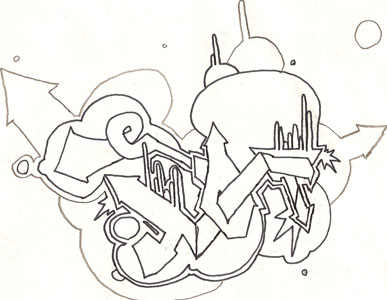
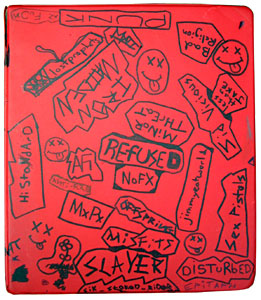
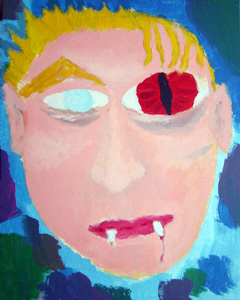
|
At about 12 years, the natural development of drawing appears to cease. Now artistic skills will be developed consciously through instructions and exercises in an observational method. The majority of drawings show an attempt at naturalistic representation. The visual appearance of the product has become much more important than the process. Self-criticism of art products continues to increase.
Pseudo-naturalistic Stage, 12 and older
Drawing characteristics:
Earlier schema has now disappeared.
Details such as wrinkles, folds become important for some.
Greater awareness of differences and gradations of color.
Great pleasure in cartooning and satirical drawing.
Increased interest in lettering design. doodling with letters, texture.
Contemporary admiration of and interest in graffitti.
Space Representation:
Greater awareness of environment, but only the important elements are drawn in detail.
Action goes on within picture plane.
Perspective can be learned, apparent reduction in size of distant objects.
Awareness of atmosphere, less detail and less intense color in distant objects.
Human Figure representation:
Naturalistic attempts, closer to correct proportions, actions and visible details.
Greater awareness of joints and body actions.
Facial expressions vary for meaning.
Person can now be represented by less than the total figure.
Sexual characteristics are over emphasized.
Self portraits are awkward and may hearken back to earlier stages.
Drawings show the artist to be self critical, introspective, idealistic,
and with a growing concern about the relationship with society.
Exercises:
1. Concentrate on flexible color use and exaggeration of form to develop emotional impact- ugliest man in world, sinister thief, jolly baker etc.
2. Exercises in facial expressions.
3. Lettering related design, influenced by designs in nature, color should be highly subjective, and emotional reactions should be highly personal.
4. Incorporate art into everyday objects, and into your everyday routines. Develop a portfolio of personal styles.
5. Create textural variations in different media.
6. Create a drawing of masses, pushed together into a recognizable form, like a clay portrait, with a focus on surface shadows.
|
SOURCES
Creative and Mental Growth, Victor Lowenfeld, MacMillan Co., 1947.
The Child's Point of View, Maureen V. Cox, Guilford Press, 1991.
The Child's Representation of the World, ed. George Butterworth, Plenum Press,1977.
Children Drawing, Jacqueline Goodnow, Harvard University Press, 1977. |
|
